Planning, preparation, effectiveness
> Luciaambrosio2
> Presentation know-how and resources
How to prepare and keep a presentation to get and keep the audience's attention. Advice on:
preparation, visuals, delivery. Guidelines and useful tips for Dos and Don'ts.
The Presentation-overview. This page is about the actual presentation itself as opposed to other aspects of giving presentations in English.

Most presentations are divided into 3 main parts (+ questions): As a general rule in communication, repetition is valuable.
How to make presentations: a funny overview. Presentation Skills Full Know-How - Table of Contents. How to make an effective presentation: planning. Writing an effective presentation. This page provides advice on how to write an effective presentation.
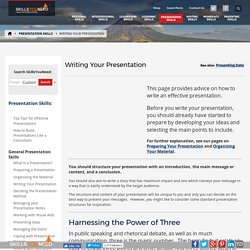
Before you write your presentation, you should already have started to prepare by developing your ideas and selecting the main points to include. For further explanation, see our pages on Preparing Your Presentation and Organising Your Material. You should structure your presentation with an introduction, the main message or content, and a conclusion. You should also aim to write a story that has maximum impact and one which conveys your message in a way that is easily understood by the target audience.
The structure and content of your presentation will be unique to you and only you can decide on the best way to present your messages. Harnessing the Power of Three In public speaking and rhetorical debate, as well as in much communication, three is the magic number. For example, your presentation should have three main elements: the introduction, middle and conclusions.
10 common presentation mistakes. Designing, Writing, and Communication Tips for presentation. If you’re in a profession where you see presentations on a regular basis, you’ve probably heard all the hate-talk directed at Microsoft PowerPoint.
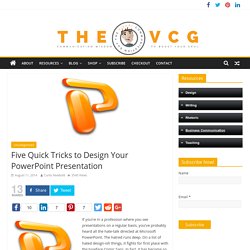
The hatred runs deep. On a list of hated design-ish things, it fights for first place with the typeface Comic Sans. In fact, it has become so uncool to use PowerPoint that simply using a different program (like Prezi or SlideRocket or Slidshare) has seemed to make presenters suddenly be cool again. For a moment, anyway. Truth is, though, PowerPoint isn’t the problem.
Five Presentation Mistakes Everyone Makes. We all know what it’s like to sit through a bad presentation.
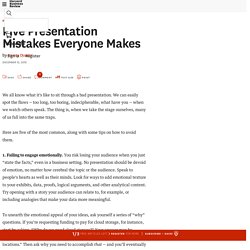
We can easily spot the flaws — too long, too boring, indecipherable, what have you — when we watch others speak. The thing is, when we take the stage ourselves, many of us fall into the same traps. Here are five of the most common, along with some tips on how to avoid them. 1. Failing to engage emotionally.
Top 10 Most Annoying Presentation Delivery Mistakes. Some people are natural presenters.

Most are not. If you have a personality that thrives when you’re in front of a group of people and your audience is always captivated and engaged when you speak, and you’re charismatic, and you move well, and you’re a true performer, well, then this post is not for you. But if you’re like the rest of us, you probably don’t love giving presentations. And you probably worry about what the audience is thinking about how you look and act and sound and how smart you seem to them. Some things you have little control over: like your facial complexion or your personality. .
#1: Going Over TimeAudiences have expectations for how long you’ll be in front of their face. .
#2: Complaining and BlamingNobody likes the complainer.
Top 12 Most Annoying PowerPoint Presentation Mistakes. PowerPoint has gotten a bad rap over the years.

In fact, during graduate school, my program director actually told us at one point that we couldn’t use PowerPoint for our comprehensive exams (which is an oral presentation in front of all the faculty and students required for graduation) because PowerPoint slides were too cliche, too dull, too obnoxious, too outdated, or whatever other undesirable quality you might slap onto a digital presentation platform. So what was the reaction?
What standup comics can teach you about public speaking. I know you have heard it a million times: Most people fear public speaking more than they fear death.
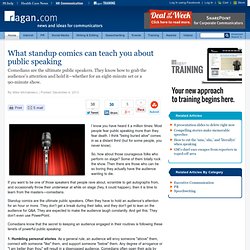
I think "being buried alive" comes in as a distant third (but for some people, you never know). So, how about those courageous folks who perform on stage? Some of them totally rock the show. Then there are those who can be so boring they actually have the audience wanting to die. If you want to be one of those speakers that people rave about, scramble to get autographs from, and occasionally throw their underwear at while on stage (hey, it could happen), then it is time to learn from the masters—comedians.
Standup comics are the ultimate public speakers. Comedians know that the secret to keeping an audience engaged in their routines is following these tenets of powerful public speaking: 1. 2. 3. 4. 5.
What you can learn from an outstanding TED talk. TED talks offer great takeaways for speakers.

I was pleased, but not at all surprised, to see Judson Brewer's TEDMED talk from 2015 about "an easy way to break a bad habit" on TED's list of the 10 most popular TED talks in 2016, with more than 6 million views and counting. Brewer was among the TEDMED speakers I coached in 2015, and I think there's much to learn from this talk, for researchers contemplating TED-style talks, and anyone else who wants to understand the form. Here are six things that make this talk work well: 1.
Steve Jobs Presentation Skills - VIDEO Business English. Steve Jobs Presentation Skills - something to marvel at.
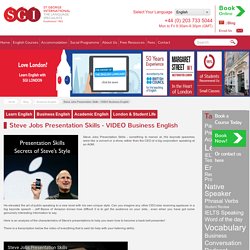
His keynote speeches were like a concert or a show, rather than the CEO of a big corporation speaking at an AGM. He elevated the art of public speaking to a new level with his own unique style. Can you imagine any other CEO else receiving applause in a big keynote speech - Jeff Bazos of Amazon knows how difficult it is to get the audience on your side... even when you have got some genuinely interesting information to say. Here is an analysis of the characteristics of Steve's presentations to help you learn how to become a back belt presenter! There is a transcription below the video of everything that is said (to help with your listening skills) [pwal id="54031297" description="Like to see the full transcription of what is being said in the video"]









